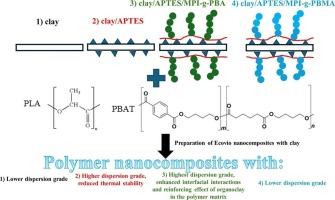功能化粘土对聚乳酸/聚己二酸丁二酯(PLA/PBAT)基可生物降解纳米复合材料的影响:热性能和流变性能
IF 5.8
2区 地球科学
Q2 CHEMISTRY, PHYSICAL
引用次数: 0
摘要
采用原始粘土和功能化粘土制备PLA/ pbat基(Ecovio)纳米复合材料,包括PBMA接枝刷和pba接枝刷,选择它们与PLA相的表面能相容性。XRD分析证实了粘土的成功嵌入和聚合物基体内良好的分散。热分析显示PLA的降解模式为典型的两步降解模式(PLA随后是PBAT), aptes功能化粘土将PLA的峰值降解温度降低至305℃。相比之下,pba接枝的粘土将其提高到329°C,而纯Ecovio为322°C。在ecovio基复合材料中添加纳米粘土对体系的整体结晶度没有显著影响。热力学和红外光谱分析表明,APTES促进了聚合物在加工过程中的降解,而PBA接枝有助于减轻这些影响。流变学测量显示,含有pba接枝粘土的Ecovio纳米复合材料在不影响加工性能的情况下增加了熔体弹性,这是包装中可堆肥薄膜应用的一个关键优势。总之,pba接枝粘土的加入提高了PLA/ pbat基纳米复合材料的相容性和热稳定性。此外,这项工作首次介绍了一种直接的策略来调整多吨位工业复合材料(如Ecovio)的性能,提供了一种实用的方法来提高性能,同时保持可堆肥性。本文章由计算机程序翻译,如有差异,请以英文原文为准。

Impact of the functionalized clay on the poly(lactic acid)/polybutylene adipate terephthalate (PLA/PBAT) based biodegradable nanocomposites: Thermal and rheological properties
PLA/PBAT-based (Ecovio) nanocomposites were prepared using both pristine and functionalized clays, including PBMA- and PBA-grafted brushes, which were selected for their surface energy compatibility with the PLA phase. XRD analysis confirmed the successful intercalation of clay and good dispersion within the polymer matrix. Thermal analysis revealed the typical two-step degradation pattern (PLA followed by PBAT), with APTES-functionalized clays lowering the peak degradation temperature of PLA to 305 °C. In comparison, PBA-grafted clays increased it to 329 °C compared to 322 °C for neat Ecovio. The addition of nanoclays to Ecovio-based composites did not significantly affect the overall crystallinity of the system. Thermomechanical and FTIR analyses indicated that APTES promoted polymer degradation during processing, whereas PBA grafting helped mitigate these effects. Rheological measurements revealed increased melt elasticity in Ecovio nanocomposites containing PBA-grafted clays without compromising processability, a key advantage for compostable film applications in packaging. Overall, the inclusion of PBA-grafted clays improved both the compatibility and thermal stability of PLA/PBAT-based nanocomposites. Moreover, this work introduces, for the first time, a straightforward strategy for tuning the properties of multi-tonnage industrial composites such as Ecovio, providing a practical approach to enhance performance while preserving compostability.
求助全文
通过发布文献求助,成功后即可免费获取论文全文。
去求助
来源期刊

Applied Clay Science
地学-矿物学
CiteScore
10.30
自引率
10.70%
发文量
289
审稿时长
39 days
期刊介绍:
Applied Clay Science aims to be an international journal attracting high quality scientific papers on clays and clay minerals, including research papers, reviews, and technical notes. The journal covers typical subjects of Fundamental and Applied Clay Science such as:
• Synthesis and purification
• Structural, crystallographic and mineralogical properties of clays and clay minerals
• Thermal properties of clays and clay minerals
• Physico-chemical properties including i) surface and interface properties; ii) thermodynamic properties; iii) mechanical properties
• Interaction with water, with polar and apolar molecules
• Colloidal properties and rheology
• Adsorption, Intercalation, Ionic exchange
• Genesis and deposits of clay minerals
• Geology and geochemistry of clays
• Modification of clays and clay minerals properties by thermal and physical treatments
• Modification by chemical treatments with organic and inorganic molecules(organoclays, pillared clays)
• Modification by biological microorganisms. etc...
 求助内容:
求助内容: 应助结果提醒方式:
应助结果提醒方式:


